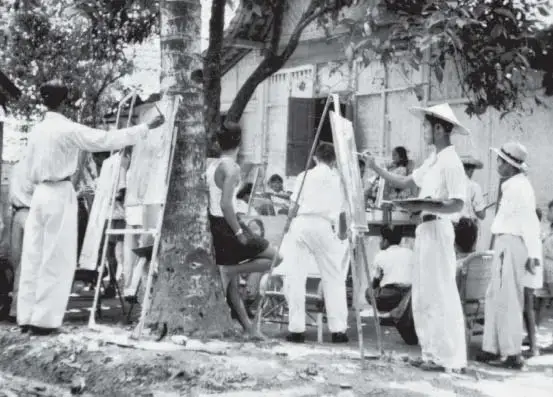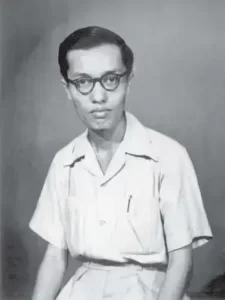After the G30S, the artworks of members of the Lembaga Kebudajaan Rakjat (LEKRA, the Institute of People’s Culture) tended to be ignored or dismissed by Indonesian culturalists. LEKRA is believed to be an underbow organization of the PKI, so it is often labeled as an evil and destructive cultural group.
Many members of Lembaga Kebudajaan Rakjat refused to let their organization be said to be affiliated with the PKI. Even Njoto, one of the founders of LEKRA, always opposed D. N. Aidit’s desire to make LEKRA an official organ of the PKI.
Table of Contents
The rise of LEKRA
Exactly five years after the proclamation of independence, on August 17, 1950, a group of artists and politicians gathered in the capital. They were A. S. Dharta, M. S. Ashar, Herman Arjuno, Henk Ngantung, Joebaar Ajoeb, Sudharnoto, D. N. Aidit and Njoto.

Their goal was not to perform art but to establish the Lembaga Kebudajaan Rakjat, or LEKRA for short.
The establishment of LEKRA cannot be separated from the political atmosphere at that time. After the Round Table Conference in 1949, artists saw that Indonesia was not yet fully independent. Therefore, LEKRA was established to free Indonesia from the shackles of colonial culture.
For them, the revolution in the country had not been completed because the influence of feudal and Western culture was still deeply rooted. Therefore, a movement was needed to support the people’s efforts to build their own culture.
According to Joebaar Ajoeb, the organization was initially projected to be like LP3S without having branches. However, as membership grew, LEKRA branches were established in various regions.
By 1951, Lembaga Kebudajaan Rakjat branches had been established in major cities such as Yogyakarta, Surabaya, Solo, Bandung, Semarang, Palembang, Manado, and Balikpapan. However, not all branches were established by LEKRA; the Indonesian Communist Party also established some.
In these big cities, LEKRA members dominated cultural performances. Balai Pemuda in Surabaya witnessed the golden age of this organization. Whenever LEKRA artists staged cultural performances such as wayang; reog; ludruk; and music, the people always crowded in to watch.
The same thing happened in Yogyakarta. According to Bumi Tarung artist Djoko Pekik, LEKRA’s leftist ideology was a strong magnet to attract young artists in the city.
First Congress
Nine years after its establishment, LEKRA finally held its First Congress in Sriwedari, Surakarta, on January 23, 1959. The congress resulted in the revision of the preamble and the establishment of the basic rules.
In addition, the 1-5-1 principle that guided LEKRA’s work was born. In this principle, cultural work with political underpinnings is combined with: expansion and elevation, high ideological quality and artistic quality, good tradition and revolutionary contemporary, individual creativity and mass wisdom, and social realism and revolutionary romance. All five are then applied through the down-to-earth method (turba).
Through the 1-5-1 principle, artists in LEKRA not only produced popular art but also went down to meet workers and peasants.
In line with the birth of the 1-5-1 principle, the institute overhauled its organizational structure. After the congress, at least six creative institutions were formed: Lembaga Seni Rupa Indonesia, Lembaga Sastra Indonesia, Lembaga Musik Indonesia, Lembaga Seni Tari Indonesia, Lembaga Seni Drama Indonesia, and Lembaga Film Indonesia.
Although LEKRA’s artists were familiar with ordinary people, their artistic skills were reliable. President Soekarno often relied on the organization’s artists to work on large projects.
State-owned hotels such as Hotel Indonesia, Ambarukmo in Yogyakarta, Bali Beach Hotel, and Samudera Beach Hotel were not spared from the cold touch of LEKRA artists. In the four hotels, LEKRA artists made relief carvings, sculptures, gardens, and paintings.
Besides working on big projects, LEKRA artists actively organized performances for significant events such as 17 Agustusan, sekatenan, or art exhibitions.
Interestingly, they had no intention of commercializing their art, as it was considered part of the struggle. It was common to set aside income to finance artistic activities for the people.
Njoto and the PKI
Talking about LEKRA is incomplete without talking about Njoto. Many may assume that Njoto’s involvement made LEKRA an official part of the PKI. However, this assumption is not entirely true.
This PKI leader not only served as the founder of LEKRA but also contributed significantly to the organization’s growth. His position as Editor-in-Chief of Harian Rakjat, the official media of the PKI, allowed LEKRA members to publish their writings in the newspaper freely.

Njoto was not like other politicians; he was a politician with an artistic spirit. Besides being a good orator, Njoto was known to write, play the saxophone, dance, and understand music. This distinguished him from Aidit, who was not actively involved in LEKRA activities.
In the 1960s, LEKRA reached its prime. In various regions, activists of the organization were eager to stage wayang wong, ketoprak, and ludruk with socialist-realist themes.
At the same time, Soekarno’s power began to weaken. The PKI, which had become the president’s main political machine after the PNI began to fizzle out, began to rack its brains to find a solution.
The rapid growth of LEKRA made D. N. Aidit ambitious to merge the organization with the PKI. He thought establishing the organization as an underbow of the PKI would strengthen support for the president. However, his idea was strongly opposed by his colleague Njoto who wanted LEKRA to remain open.
Njoto’s opposition was justified because, from its inception, the organization consisted of artists from various backgrounds. In fact, two of LEKRA’s founders, A. S. Dharta (a member of the Murba Party) and M. S. Ashar were not communist artists. In addition, the idea of a merger could lead to the departure of influential artists such as Pramoedya Ananta Toer, Utuy Tatang Sontani, and Affandi Koesoema.
After failing to GPKIize LEKRA, Aidit was forced to look for another solution. The PKI finally decided to organize a Revolutionary Literature and Art Conference.
The conference was just as grand as LEKRA’s First Conference. Artists from various regions were invited to the event, including LEKRA leaders.
During the event, Aidit repeatedly praised LEKRA and gave the stage to the organization’s leaders, but those who attended emphasized that they came personally, not representing the organization.
Although LEKRA has always denied being an official part of the PKI throughout its existence, it is hard to deny that the presence of PKI officials in the organization facilitated its development.
Aidit failed to PKI-ize LEKRA, but Soeharto succeeded. The close relationship between the organization and the PKI became the basis for destroying the organization after the G30S tragedy.
Along with other PKI-affiliated organizations, LEKRA members were targeted at the time. Many were arrested, tortured, and thrown into prison without trial.
The misfortune of LEKRA members did not stop at that point. Through the Instruction of the Minister of Basic Education and Culture No. 1381/1965, many of their works were banned and withdrawn from circulation.
In addition, the freedom to work and live for former LEKRA members was taken away. Being labeled ex-political prisoners shackled their lives, often pushing them to the brink of poverty.
Bibliography
Bodden, M. “Dynamics and tensions of LEKRA’s modern national theatre, 1959-1965.” In Heirs to world culture; Being Indonesian 1950-1965. Leiden: KITLV Press, 2012.
Tempo. LEKRAdan Geger 1965. Jakarta: KPG, 2014.
Toer, P. A.. Realisme Sosialis dan Sastra Indonesia. Jakarta: Lentera Dipantara, 2003.
Yuliantri, R. D. A and Dahlan, M. M. LEKRAtak Membakar Buku: Suara Senyap Lembar Kebudayaan Harian Rakyat Harian Rakyat 1950-1965. Yogyakarta: Merakesumba, 2008.
Yuliantri, R. D. A. “LEKRA and ensembles; Tracing the Indonesian musical stage.” Dalam Heirs to world culture; Being Indonesian 1950-1965. Leiden: KITLV Press, 2012.